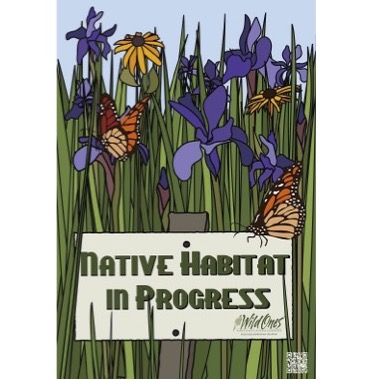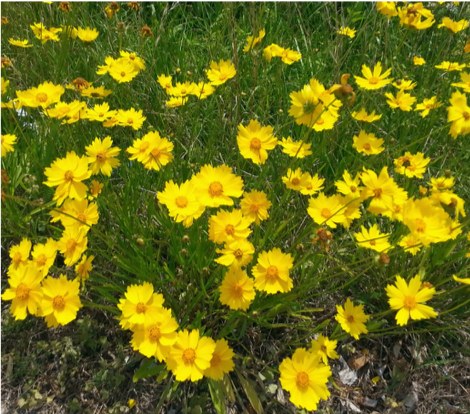
Help Us Design a New Sign
We’ve sold out of our old garden sign (left) and are planning to order new ones. We’ll probably keep the artwork, but folks want to try some new language. You can help us choose by filling out this survey. Caveat, the form works better on a computer than on a phone.
Great turnout at annual meeting
A total of 34 members showed up to eat pizza, socialize, and connect with their Wild Ones chapter at our annual meeting Sept. 16 at Studio Pizza. That’s more than one-third of our membership (94 including household partners, 81 paid memberships) and the biggest turnout yet for a group get together. (If you missed it, that’s OK, just be sure to sign up for our holiday party in December.)
All the candidates were elected to our board of directors, including Julie Carson, Susan Miko, Sheri Hagwood, and Roz Heidke. The board chose officers for 2025-26, including Marcia Goodrich, president; Karen Cayce, vice president; Sheri Hagwood, secretary; Josh Roys, treasurer; and Polly Havins, membership chair.
Since we have sold out of our garden signs, we solicited ideas for new ones. Those thoughts have been shared with the membership in a ranked survey. If you think you might want a sign, please answer the survey you received in your email Sept. 21. We don’t want to order a sign everybody hates.
Also at the party, we learned about the chapters activities over the past year and distributed door prizes, including plants, books, and Garden Markers. Special thanks to the hospitality committee, which brought a variety of desserts to share.

Let’s do more plant swaps
At Polly Havins’s insistance, WOK had its first plant swap ever this year on a warm, rainy September afternoon, and despite our initial doubts (it’s raining, for crying out loud), we had a great time.
That was thanks largely to Julie Carson, who sheltered us in her garage. About 9 members came and shared excess plants from their yards. They ranged from common (blue vervain) to unusual (round-leafed hepatica). Those with shovels could dig coreopsis (left) from Julie’s yard.
You don’t have to bring plants to play. Those who shared plants were just happy to find good homes for their surplus population.
A Wonderful Wetland Walk
Rebuilding a wetland is a bit more complicated than “Add water and stir.” Nineteen participants learned a little about what it takes when Dr. Rodney Chimner, a wetland ecologist at Michigan Tech, led a Sept. 13 exploration of several engineered or restored wetlands near the Houghton County Memorial Airport.
The tour included part of a 28-acre restoration project ordered by the State of Michigan after the Keweenaw Research Center inadvertently destroyed some nearby wetlands during the expansion of its test track system. Chimner led the million-dollar-effort, which is now yielding spectacular results, especially among amphibian species. American Toads began showing up almost immediately in the thousands, and workers have spied eggs of the Blue-Spotted Salamander.
A key part of the project was installing about $20,000 worh of wetland plant seed, primarily grasses, rushes, and sedges, Chimner said. Planted just a year ago, those plants are thriving, in part because wetland plant seeds are programmed to germinate profusely during those rare times when conditions are ideal.
Weland work can involve as much civil engineering and hydrology as ecology. The first new wetland we saw was a chain of three small sites, each with a different water level and plant community, which encourages biodiversity. The flora included sundew carnivorous plants and the orchid Great Plains Lady’s Tresses.
Chimner admitted to having second thoughts about the next site, a drainage ditch cum infant wetland alongside a dirt road. Torrential stormwater runoff is not conducive to wetland creation. But the conditions allowed him to use traditional rock barriers called media luna (half moon in Spanish) to slow the water flow. Now, the thick vegetation also tames the runoff and keeps erosion at bay.
The third site involved adding and removing “countless tons” of dirt to create a flat plain. Now the biggest challenge will be removing invasive cattails, which relentlessly overwhelm the local topography.
The final stop was the former site of an old earthen dam, which had been removed to restore the wetland and allow a small creek to run free. This wetland was unique in the 28-acre project; while it is now covered with lush vegetation, it was not reseeded. The plants sprouted from seeds drowned under water almost a century ago. Furthermore, unlike the other sites, it is not burdened by cattails and other invasive nonnatives, at least not yet. It also includes some open water and attracts plenty of waterfowl and shoreline birds.
The restoration is only a year old, but its success has already drawn the attention of the powers that be. “The state is so happy with it that they want to use it as a training site,” said Chimner.







Other things…
Our plant sale is done for the year. Members managing public gardens will be getting leftover plants free for their spaces, and then we will provide free plants to local schools.
Marcia gave a “Why Natives?” talk at a meeting of the Baraga chapter of the Michigan Association of Retired School Personnel on Sept 2. They were a friendly, welcoming audience and seemed happy to hear me preach the native plant gospel.
Marcia and Cassandra Reed-VanDam went to the Copper Island Academy and talked with second grade teacher Katelyn Daavettila about her efforts to add native gardening and erosion control to the curriculum. More to come on this.
